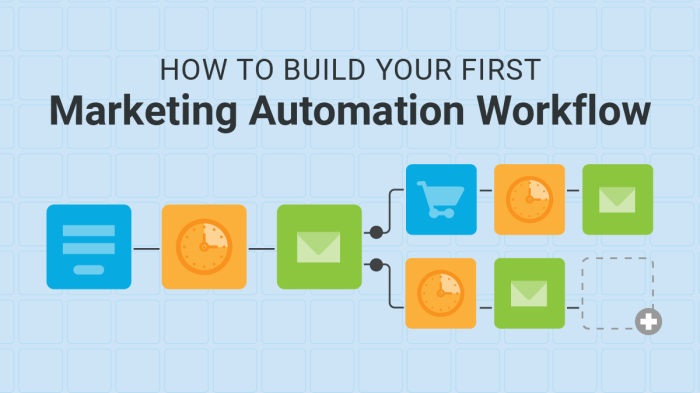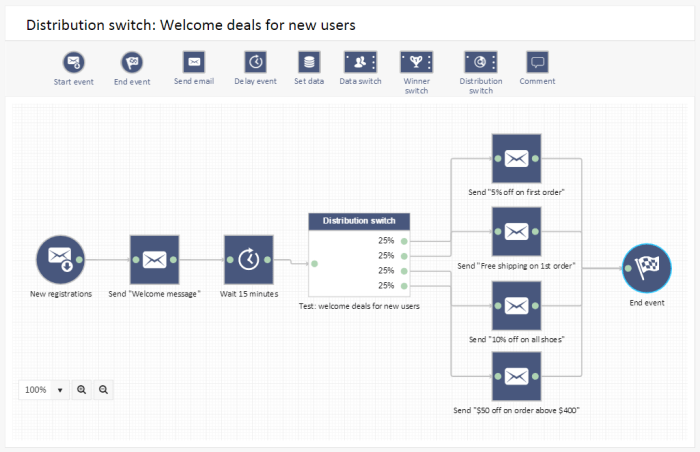Building a Marketing Automation Workflow sets the stage for revolutionizing your marketing game. Dive into the world of automation and take charge of your strategy like never before.
From understanding the basics to designing and integrating, this guide will walk you through each step of the process with expert tips and insights.
Understanding Marketing Automation Workflow

Marketing automation workflow refers to the process of using technology to streamline and automate marketing tasks and workflows. This allows businesses to effectively target prospects with personalized messages at the right time, without manual intervention.
Examples of Tasks that can be Automated in Marketing
- Lead nurturing: Sending personalized emails to leads based on their behavior and interests.
- Social media scheduling: Automating posts on various social media platforms at optimal times.
- Analytics tracking: Automatically collecting and analyzing data to measure campaign performance.
- Segmentation: Automatically categorizing leads into different groups based on behavior or demographics.
Benefits of Implementing a Marketing Automation Workflow
-
Increased efficiency:
By automating repetitive tasks, marketers can focus on strategy and creativity, leading to higher productivity.
-
Improved lead nurturing:
Personalized and timely communication with leads can lead to higher conversion rates and customer retention.
-
Enhanced targeting:
Automation allows for more precise targeting based on customer data and behavior, resulting in more effective campaigns.
-
Better ROI:
With automation streamlining processes and improving targeting, businesses can see a higher return on investment from their marketing efforts.
Components of a Marketing Automation Workflow
Marketing automation workflows consist of various essential components that work together to streamline and optimize marketing processes. These components include:
1. Triggers
Triggers are events or actions that initiate the automation workflow. These can be user actions, such as signing up for a newsletter, making a purchase, or abandoning a shopping cart.
2. Actions
Actions are the steps that the system takes once a trigger is activated. This can include sending out an email, updating a customer’s profile, or assigning a lead score based on their behavior.
3. Conditions
Conditions are rules that determine the path the workflow will take based on certain criteria. For example, if a customer opens an email, they may be placed on a different email nurturing track than those who do not open it.
4. Goals
Goals are the desired outcomes of the workflow. These can include converting a lead into a customer, increasing engagement, or driving sales.
5. Reporting and Analytics, Building a Marketing Automation Workflow
Reporting and analytics are essential components that allow marketers to track the performance of the workflow. This data helps in evaluating the effectiveness of the workflow and making necessary adjustments for improvement.
When it comes to choosing the right automation tool for creating workflows, there are several options available in the market. Some popular automation tools include HubSpot, Marketo, Pardot, and ActiveCampaign. Each tool offers unique features and capabilities, so it is important to assess your specific needs and goals before making a decision.
To organize and structure workflow components effectively, it is recommended to:
– Clearly define your goals and objectives for the workflow.
– Map out the customer journey and identify key touchpoints.
– Segment your audience based on behavior, demographics, or other criteria.
– Test and optimize your workflows regularly to ensure maximum efficiency and effectiveness.
– Collaborate with various teams within your organization to align marketing automation efforts with overall business goals.
By incorporating these best practices and utilizing the right tools, you can create a well-structured and successful marketing automation workflow that drives results for your business.
Designing a Marketing Automation Workflow: Building A Marketing Automation Workflow
When it comes to designing a successful marketing automation workflow, there are several key steps that need to be followed to ensure effectiveness and efficiency in your marketing strategies.
Setting Goals and Objectives
- Identify your target audience and understand their needs and preferences.
- Establish clear and measurable goals for your marketing automation workflow.
- Define specific objectives that align with your overall business objectives.
- Ensure that your goals are realistic and achievable within a set timeframe.
Mapping Out Customer Journeys
When mapping out customer journeys within your marketing automation workflow, it is important to consider the following:
- Identify different touchpoints where your customers interact with your brand.
- Understand the specific actions and behaviors of your customers at each touchpoint.
- Segment your audience based on their behaviors, preferences, and demographics.
- Create personalized content and messaging for each segment to guide them through the customer journey.
Implementing and Testing the Workflow
Implementing a marketing automation workflow involves setting up the sequence of actions and triggers that will guide leads through the marketing funnel. This includes creating email campaigns, setting up lead scoring, and defining the criteria for moving leads from one stage to the next.
Strategies for Testing and Optimizing the Workflow
- Run A/B tests on different elements of the workflow, such as email subject lines, CTAs, and landing pages, to see which performs best.
- Monitor key performance indicators (KPIs) like open rates, click-through rates, and conversion rates to identify areas for improvement.
- Segment your audience based on behavior and demographics to tailor the workflow to different groups of leads for better results.
- Regularly review and optimize the workflow based on data and feedback to ensure it remains effective and efficient.
Importance of Monitoring and Analyzing Data
Monitoring and analyzing data is crucial for improving the marketing automation workflow. By tracking and analyzing metrics like engagement rates, conversion rates, and ROI, you can identify bottlenecks, refine targeting strategies, and make data-driven decisions to enhance the overall performance of the workflow.
Integrating Different Marketing Channels

In today’s digital landscape, integrating different marketing channels into your automation workflow is crucial for reaching your target audience effectively. By combining various channels such as email, social media, SMS, and more, you can create a cohesive and engaging experience for your customers.
Examples of Cross-Channel Campaigns
- One example of a cross-channel campaign that can be automated is sending a promotional email to customers who have engaged with your social media posts. By tracking their interactions and automating the email send, you can nurture leads and drive conversions seamlessly.
- Another example is using SMS notifications to remind customers about an upcoming webinar that was promoted on social media. By integrating SMS with your automation workflow, you can increase attendance rates and engagement.
Challenges and Benefits of Integrating Multiple Channels
- Challenges:
- Managing multiple channels can be complex and time-consuming, requiring careful coordination and monitoring.
- Ensuring consistent messaging and branding across all channels can be a challenge, especially when automating campaigns.
- Data integration and tracking performance across channels may require specialized tools and expertise.
- Benefits:
- Increased reach and engagement with your target audience by leveraging multiple touchpoints.
- Improved customer experience by providing a seamless and cohesive journey across different channels.
- Enhanced personalization and targeting capabilities by combining data from various channels to tailor messaging.
